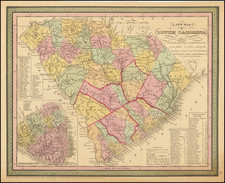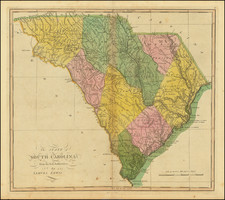Early Colonial South Carolina Land Document - Printed on Vellum
Likely Printed by Peter Timothy in Charleston
A very early colonial document signed by James Glen, the colonial governor of South Carolina, and likely printed by Peter Timothy, the son of the first female newpaper publisher in colonial America. The document, notably printed on vellum, grants 150 acres of land located at the fork of the Broad and Saluda Rivers, northwest of Columbia, South Carolina.
Christopher Gould and Richard Morgan date the earliest printing in South Carolina from 1731, making the present document a quite early piece of colonial printing. The first printing was Thomas Whitemarsh's South Carolina Gazette, first published on January 8, 1731. But even by 1751 (the date of our document) Gould & Morgan record only two confirmed South Carolina imprints - an almanack and a law book (ephemeral and single sheet form documents were not included by Gould & Morgan).
A Franklin Connection
The present document was likely printed by Peter Timothy, who inherited the Charleston printing business established by his father, Louis Timothy. The elder Timothy had worked as a printer under Benjamin Franklin in Philadelphia. When Louis died in 1738, his wife, Elizabeth, continued to work within Franklin's network of printing partners stewarding the business until her son came of age to run the organization, which happened about 1746. At the time of our land document (1751), Elizabeth Timothy was apparently no longer in Charleston. As noted by Reese:
... in 1731-33, three printers responded to the bounty offered by South Carolina to found a press. Eleazar Phillips and Thomas Whitmarsh quickly succumbed to the climate, while a third, George Webb, printed only a few items and disappeared. Louis Timothy, like Whitmarsh an employee of Benjamin Franklin and working with Franklin as a silent partner, became the sole printer in 1734. When he died in 1738 his widow Elizabeth took over the press with her young son.
According to the South Carolina Encyclopedia:
Little is known of Elizabeth Timothy’s origins and early life. Benjamin Franklin described her as “born and bred in Holland.” She was married to Louis Timothée, a French-born immigrant from Rotterdam. Together with their four young children, the couple sailed to Philadelphia in 1731. Louis worked as a French instructor and soon after established an association with Franklin, who helped him become a journeyman printer for the Pennsylvania Gazette. In November 1733 Franklin established Louis in a six-year business partnership as the new printer of the South-Carolina Gazette. While Louis prepared the first issue of his Charleston newspaper, Elizabeth settled family business in Philadelphia before moving her family to South Carolina in March 1734. The family became established members of lowcountry society. The name Louis was anglicized to “Lewis” and Timothée became “Timothy,” and the family was registered at St. Philip’s Church. By 1736 Lewis Timothy prospered as a landholder and printer, serving as the official colonial printer for South Carolina. In December 1738 Lewis died as the result of “an unhappy Accident,” leaving Elizabeth in the care of “six small Children and another hourly expected.” She had already mourned the loss of two of her children by 1737.
According to the arrangement between her husband and Franklin, Elizabeth’s eldest son, Peter, was to carry on the business in the event of his father’s death. But because of Peter’s youth, she assumed control of the printing office as well as responsibility for her family.
The newly widowed Elizabeth published the next issue of the Gazette on January 4, 1739, pledging “to make it as entertaining and correct as may be reasonably expected.” By the end of the year, she bought out Franklin’s interest in the partnership and became the first woman in the American colonies to own and publish a newspaper. Franklin praised her regular and exact accounting and commended her for both raising a family and purchasing the printing operation from him.
Elizabeth gradually relinquished control of printing operations when Peter came of age in 1746. Requests for payment from the South Carolina Commons House of Assembly from 1740 to 1743 in Elizabeth’s name show her reliance on the revenues as public printer. In addition to publishing the Gazette and colonial laws, she sold legal blanks, broadsides, and stationery and established a bookstore adjacent to her son’s printing office.
Elizabeth drafted her will on April 2, 1757, and was buried two days later at St. Philip’s Church.
Signed by Colonial Governor of South Carolina
James Glen served as the colonial governor of South Carolina from 1743 to 1756, the longest tenure of any governor in the colony's history. His administration was marked by significant dealings with Native American tribes, particularly on the colony's western and southern borders. Glen is noted for negotiating the 1755 Treaty of Saluda Old Town with the Cherokee and overseeing the construction of Fort Prince George. He also promoted policies to create animosity between Native Americans and African Americans to prevent alliances. During King George's War, Glen's trade delegation, led by James Adair, attempted to shift Choctaw allegiance from the French to the British, a mission that ultimately failed and led to a Choctaw civil war.
The document also bears the signature of Glen's secretary, Alexander Gordon (c.1692-1755), noted Scottish antiquary who came to South Carolina in August 1741.
Rarity
Printed documents from such an early date in colonial South Carolina are rare in the market.
Transcription
SOUTH CAROLINA
GEORGE the Second, by the Grace of God, of Great-Britain, France and Ireland, KING, Defender of the Faith, &c.
To all to whom these Presents shall come, Greeting.
Know ye, that We, of Our special Grace, certain Knowledge, and meer Motion, have Given and Granted, and by these Presents, for Us, Our Heirs and Successors, do Give and Grant unto Nicholas Pressler ~ Heirs and Assigns a tract of one hundred and fifty acres of Land in the fork getween Broad & Saluda Rivers on a Creek called Crim's Creek Bounded on all sides by ??? Land
And hath such Shapes, Forms and Marks, as appears by a Plat thereof annexed, together with all Woods, Underwoods, Timber and Trees, Lakes, Ponds, Fishings, Waters, Water-Courses, Profits, Commodities, Appurtenances, and Hereditaments whatsoever thereunto belonging, or in any wise appertaining; together with Privilege of Hawking, Hunting, and Fowling in and upon the same, and all Mines and Minerals whatsoever; Saving and Reserving, nevertheless, to Us, Our Heirs and Successors, one Tenth Part of Mines of Silver and Gold only. TO HAVE and TO HOLD the said Tract of one hundred and fifty Acres of Land, and all and singular the Premises hereby granted, with the Appurtenances unto the said Nicholas Pressler his Heirs and Assigns for ever, in free and common Soccage. He the said Nicholas Pressler his Heirs or Assigns yielding and paying therefor unto Us, Our Heirs and Successors, or to our Receiver-General for the Time being, or to his Deputy or Deputies for the Time being, yearly, that is to say, on every twenty-fifth Day of March, at the Rate of Three Shillings Sterling or Four Shillings Proclamation Money, for every Hundred Acres, and so in Proportion, according to the Quantity of Acres contained herein, the same to grow due and be accounted from the Date hereof. PROVIDED always, and this present Grant is upon Condition, nevertheless, That the said Nicholas Pressler his Heirs or Assigns shall and do, within Three Years next after the Date of these Presents, clear and cultivate at the Rate of One Acre for every Five Hundred Acres of Land, and also shall and do, within the Time and in Proportion for a greater or lesser Quantity, add and keep a Stock of Five Head of Cattle for every Five Hundred Acres, upon Condition, That if the said Rent hereby reserved, shall happen to be in arrear and unpaid for the Space of Three Years from the Time it became due, and no Distress can be found on the said Lands, Tenements and Hereditaments hereby Granted, or any Part and Parcel thereof, that then and in such Case, the said Lands, Tenements and Hereditaments hereby Granted, and every Part and Parcel thereof, shall revert to Us, Our Heirs and Successors, as fully and absolutely as if the same had never been Granted. Provided also if the said Lands hereby granted shall not be settled and planted within the Limits of our Instructions, that then this Grant shall be void, any Thing herein contained to the Contrary notwithstanding.
Given under the Great Seal of Our said Province. Witness,
Governor and Commander in Chief in and over Our said Province of South Carolina, this twenty seventh Day of Augusust Anno Domini 1751, in the Twenty-fifth Year of Our Reign.











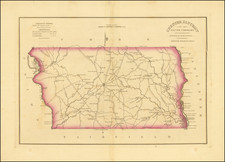
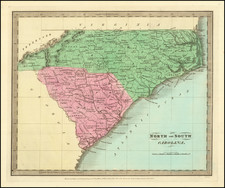
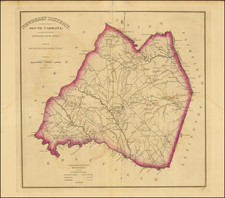
![[Untitled Coast chart of North Carolina, South Carolina, Georgia, and Florida, with insets of the harbor of Charleston, S.C. and the entrance of the Saint Johns River]](https://storage.googleapis.com/raremaps/img/small/91737.jpg)
